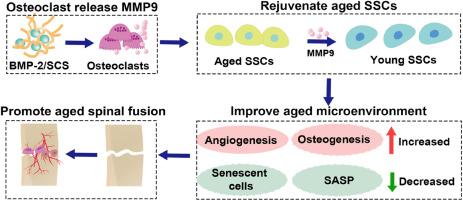Sulfated chitosan enhances BMP-2-mediated spinal fusion via skeletal stem cell rejuvenation in aging
IF 18
1区 医学
Q1 ENGINEERING, BIOMEDICAL
引用次数: 0
Abstract
Spinal degenerative diseases in elderly patients often require spinal fusion, but outcomes are limited by an aging microenvironment and stem cell dysfunction or depletion. In this study, we developed a bone morphogenetic protein-2 (BMP-2)/sulfated chitosan (SCS)/calcium phosphate cement (CPC) composite scaffold to enhance spinal fusion in aged mice. BMP-2/SCS significantly improved spinal fusion success rates (83.3 %) compared to BMP-2 alone (16.7 %) and high-dose BMP-2 (50 %). The BMP-2/SCS group promoted robust new bone formation and H-type vessel development, facilitating vascular-bone coupling in the fusion region. Mechanistically, SCS suppressed BMP-2-induced osteoclast overactivation and reduced MMP-9 secretion, leading to vertebral skeletal stem cell (vSSC) rejuvenation. Rejuvenated vSSCs primarily differentiated into the osteogenic bone/cartilage lineage while stromal lineage differentiation was suppressed. In contrast, co-administration of BMP-2 and alendronate sodium abolished BMP-2-mediated increases in vSSC numbers, vSSC rejuvenation, and bone integration, highlighting the indispensable role of osteoclast activity in BMP-2-induced bone regeneration. Collectively, this study demonstrates that BMP-2/SCS scaffolds effectively reverse age-related deficiencies by creating a rejuvenated bone microenvironment, promoting vascular-bone coupling, and enhancing osteogenesis, offering a promising strategy to improve spinal fusion outcomes in elderly patients.

硫酸壳聚糖通过骨骼干细胞再生促进bmp -2介导的脊柱融合
老年患者的脊柱退行性疾病通常需要脊柱融合,但结果受到衰老微环境和干细胞功能障碍或耗竭的限制。在这项研究中,我们开发了骨形态发生蛋白-2 (BMP-2)/硫酸壳聚糖(SCS)/磷酸钙水泥(CPC)复合支架来增强老年小鼠脊柱融合。与单独使用BMP-2(16.7%)和高剂量BMP-2(50%)相比,BMP-2/SCS显著提高了脊柱融合成功率(83.3%)。BMP-2/SCS组促进了稳健的新骨形成和h型血管发育,促进了融合区血管-骨耦合。机制上,SCS抑制bmp -2诱导的破骨细胞过度活化,减少MMP-9分泌,导致椎骨干细胞(vSSC)年轻化。再生的血管间充质干细胞主要分化为成骨性骨/软骨谱系,而间质谱系分化受到抑制。相反,BMP-2和阿仑膦酸钠联合给药可消除BMP-2介导的vSSC数量增加、vSSC年轻化和骨整合,这突出了破骨细胞活性在BMP-2诱导的骨再生中不可或缺的作用。总的来说,本研究表明BMP-2/SCS支架通过创造一个恢复活力的骨微环境,促进血管-骨耦合和促进成骨,有效地逆转年龄相关的缺陷,为改善老年患者的脊柱融合结果提供了一个有希望的策略。
本文章由计算机程序翻译,如有差异,请以英文原文为准。
求助全文
约1分钟内获得全文
求助全文
来源期刊

Bioactive Materials
Biochemistry, Genetics and Molecular Biology-Biotechnology
CiteScore
28.00
自引率
6.30%
发文量
436
审稿时长
20 days
期刊介绍:
Bioactive Materials is a peer-reviewed research publication that focuses on advancements in bioactive materials. The journal accepts research papers, reviews, and rapid communications in the field of next-generation biomaterials that interact with cells, tissues, and organs in various living organisms.
The primary goal of Bioactive Materials is to promote the science and engineering of biomaterials that exhibit adaptiveness to the biological environment. These materials are specifically designed to stimulate or direct appropriate cell and tissue responses or regulate interactions with microorganisms.
The journal covers a wide range of bioactive materials, including those that are engineered or designed in terms of their physical form (e.g. particulate, fiber), topology (e.g. porosity, surface roughness), or dimensions (ranging from macro to nano-scales). Contributions are sought from the following categories of bioactive materials:
Bioactive metals and alloys
Bioactive inorganics: ceramics, glasses, and carbon-based materials
Bioactive polymers and gels
Bioactive materials derived from natural sources
Bioactive composites
These materials find applications in human and veterinary medicine, such as implants, tissue engineering scaffolds, cell/drug/gene carriers, as well as imaging and sensing devices.
 求助内容:
求助内容: 应助结果提醒方式:
应助结果提醒方式:


